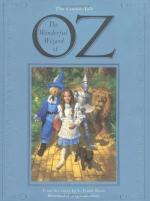|
This section contains 4,902 words (approx. 17 pages at 300 words per page) |

|
SOURCE: Tuerk, Richard. “Dorothy's Timeless Quest.” Mythlore 17, no. 63 (autumn 1990): 20-4.
In the following essay, Tuerk finds that, despite Baum's assertions that his book differed from the pattern of European fairy-tales, The Wonderful Wizard of Oz is in fact structured as a monomyth.
In the preface to The Wonderful Wizard of Oz L. Frank Baum calls his book “a modernized fairy tale, in which the wonderment and joy are retained and the heart-aches and nightmares are left out.” He tried, he writes, to eliminate from it “the stereotyped genie, dwarf and fairy …, together with all the horrible and blood-curdling incident devised by … [the] authors” of European fairy stories “to point a fearsome moral to each tale” (2).
As readers recognize, however, Baum is a better creator than critic.1 In his book, Dorothy and her companions face “monstrous” Kalidahs with “bodies like bears and heads like tigers” (42), a witch “so wicked...
|
This section contains 4,902 words (approx. 17 pages at 300 words per page) |

|


